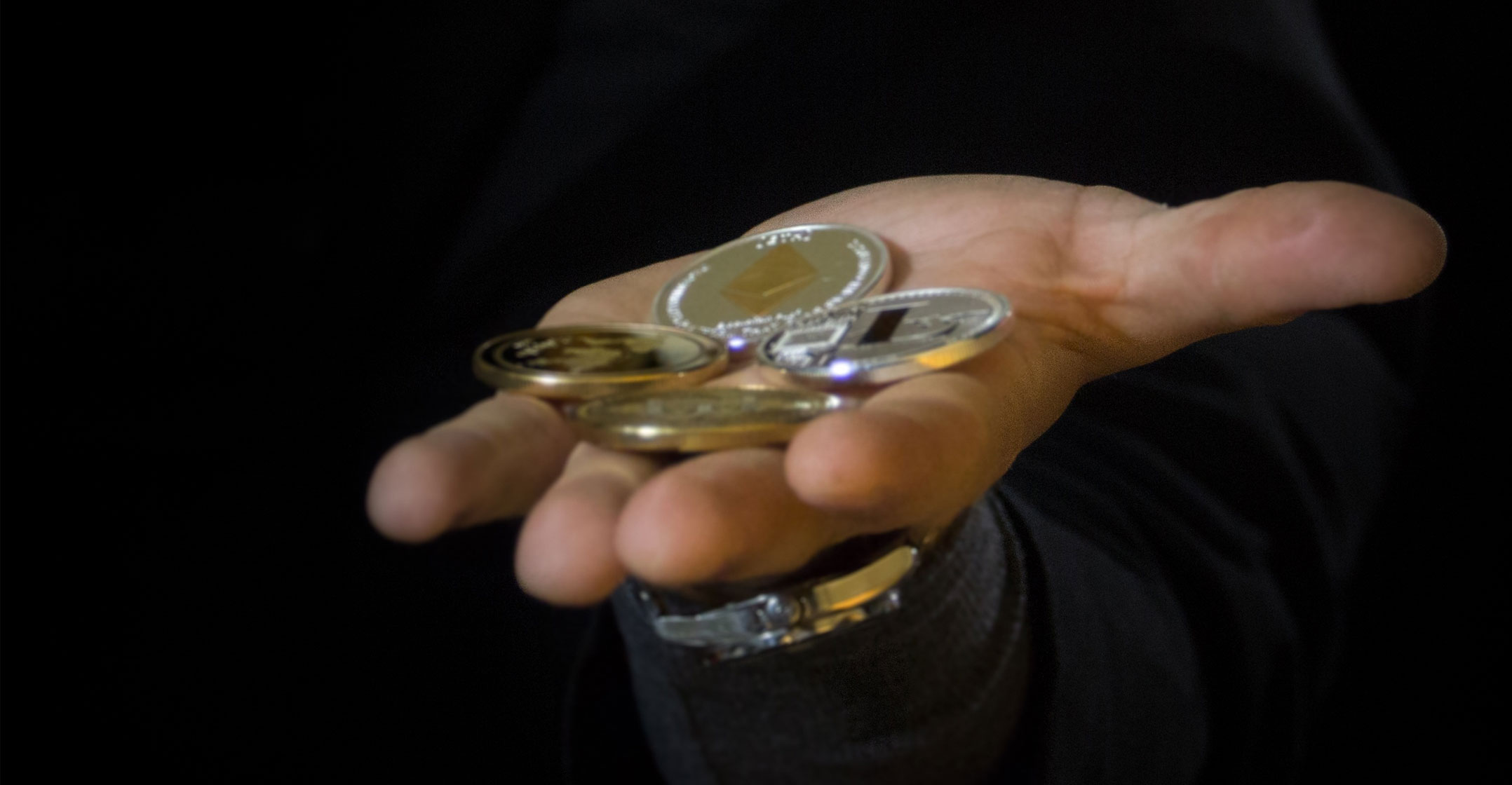You remember the Money Chant: Matthew McConaughey thumping his chest, talking fools and money before — sniff! — a little lunchtime “tootski”.
Titan Maxamus has been there. Well, not there, in a Wolf of Wall Street-style boiler room. There on the other side — as the mark. Titan Maxamus knows the game. All the brazenly cynical players do. In Scorsese’s cinematic bender of sex, drugs and stocks, it’s called the pump and dump. In today’s cryptocurrencies, it’s known as the rug pull.
Maxamus thinks he got rug-pulled the other month in some sketchy digital token called — wait for it — Safe Heaven. Like countless dreamers in today’s memeified markets, he’s been gambling US$50 here, $100 there on what are known as “shitcoins”, obscure digital something-or-others being minted by the thousands. This stuff makes bitcoin look good as gold.
One moment, Safe Heaven was flying. The next it was crashing. Maxamus (his real name is Glenn Titus) can’t prove anything. But he suspects what, in retrospect, seems forehead-slappingly obvious: Some small-time hustler created Safe Heaven with a few deft keystrokes, hyped the hell out of it — and promptly cashed out. Telegram, a popular instant messaging app that’s become a major crypto boiler room, immediately fell silent. The Safe Heaven Telegram group, once thronging with rocket emojis and Elon Musk gifs, was deleted. The Safe Heaven Twitter account hasn’t been updated since 28 May.
Rug-pulled
“Everybody I know has gotten rug-pulled,” says Titus, a 38-year-old butcher in Salem, Oregon. “You know, you win some, you lose some. Hopefully, win more than lose.”
It might sound like a joke, given the crypto meltdowns of late, but serious money is at stake here. Billions — real billions — are getting pilfered annually through a variety of cryptocurrency scams. The way things are going, this will only get worse.
Back in the Wall Street Dark Ages — six, 12, 18 months ago — these sorts of shenanigans were mostly associated with shlocky brokerages like the one depicted in the 2013 Wolf. In those halcyon days before GameStop, dogecoin and the rest, schlubs on Long Island might pitch ridiculous over-the-counter stocks to the gullible.
 Nowadays crypto hustlers and star-gazers like Titan Maxamus have established a weird symbiotic relationship. It seems to capture everything that’s gone wrong with money culture, from Reddit-fueled thrill-seeking to conspiracy theorising to predatory wheeling-dealing. The rug pull is only one play. There’s also the gentler soft rug, the crypto version of getting ghosted on Hinge. And the honey pot, which functions like a trap. Old-fashioned Ponzi schemes, newly crypto-denominated, have swindled people out of billions, too.
Nowadays crypto hustlers and star-gazers like Titan Maxamus have established a weird symbiotic relationship. It seems to capture everything that’s gone wrong with money culture, from Reddit-fueled thrill-seeking to conspiracy theorising to predatory wheeling-dealing. The rug pull is only one play. There’s also the gentler soft rug, the crypto version of getting ghosted on Hinge. And the honey pot, which functions like a trap. Old-fashioned Ponzi schemes, newly crypto-denominated, have swindled people out of billions, too.
At times, the result can start to resemble the Agatha Christie mystery classic, Murder on the Orient Express: The who in this dunnit is somehow everyone. Grifters will grift. But like Maxamus, many marks actually expect to get snookered once in a while. Both sides, the swindler and the swindled, are in on this one. Elaborate social media systems have sprung up to flag potential trouble, not only to avoid it but maybe even to profit from it.
Many who feel they’ve been ripped off just shrug. They chalk it up to the cost of doing crypto, the price of buying a lottery ticket that maybe just might hit that big jackpot.
Titan Maxamus says he’s still in the money, swindlers be damned. And he’s not giving up. He’s got anywhere from $20 to $1 000 in dozens of different meme coins. (A recent pick, Blue Lighting, looks like it fell victim to a honey pot — more on that later).
“People have a fear of missing out on the next big thing, so they’re just dumping money here and there,” Maxamus said with earnest understatement, just before bitcoin and shit coins began to crater recently. He concedes his own Fomo (fear of missing out) lured him into a rug-pull or three. “I guess you never know,” he reflects. “That’s part of the risk you take.”
Tokensniffer
The list on Tokensniffer.com runs on and on. Six minutes ago, CatRocket. One hour ago, MoonMiner. Three hours ago, GoldenShiba. Four hours ago, EverRise. So it goes, hour after day after week after month, in a sort of running Trip Advisor review of bad crypto experiences. They all appear under the same heading: “Latest Scams & Hacks.” Tokensniffer, aptly named for shitcoins, claims to have tracked 42 071 tokens and 2 250 scams or hacks. That was as of 16 June. More than 200 supposed stings were logged by users during the first two weeks of June alone.
Just how many of these coins have actually been rug-pulled, soft-rugged or otherwise manipulated is anyone’s guess. The website was developed in October 2020 by a software-engineer-cum-crypto-trader. He is 44 years old and lives in the western US. Like many players in crypto, he prefers to remain anonymous.
The idea for Tokensniffer came to him after he fell victim to rug pulls himself. His website scrapes data about new meme tokens from popular social media channels and scans the source code. Sometimes users also flag tokens that aren’t in the system. Tokensniffer functions a bit like a virus scanner looking for malicious code patterns. A “smell test” program searches for vulnerabilities. Clones of existing meme tokens are often a red flag. Most recent scams — the site flagged 450 in in one recent 30-day period — were honeypots. Those tend to be easier to spot because of their code, Tokensniffer’s creator says. Rug pulls are more complicated.

Such supposed safeguards aside, people are getting scammed in growing numbers. So far this year, over $2.6-billion has been grabbed, according to Chainanalysis, a New York-based blockchain researcher. That figure doesn’t include a giant Ponzi scheme that just came to light in South Africa. Local authorities put the haul at $3.6-billion worth of bitcoin. Gob-smacking as all of this might sound, these numbers in fact represent a marked decline from 2019, when fraudsters walked away with an estimated $9-billion.
But here’s a key difference: The sheer number of people getting hoodwinked. With a few outsize exceptions, most crypto scams seem to be getting smaller. That’s the good news. The bad news is that there are more of them, and more people are getting stung. From 2019 to 2020, the number of victims has jumped 48% to an estimated 7.3 million, a figure approaching the official population of Hong Kong. Between the last three months of 2020 and the first three months of 2021, the number of unique scams rose nearly 18%, to 1 335, according to Chainalysis.
Most individual scams are so small that the authorities don’t bat an eye. Regulators around the world tend to prioritise cases involving lots of money, or violations that seem particularly egregious. Cases involving less than $100 000 tend to get a pass, and buyers have little incentive to chase after fraudsters on their own. Most swindlers simply disappear. The phenomenon is big, growing — and global. Some crypto wolves work alone, others in packs, and almost all use online aliases. Even people who are in on the same scam don’t necessarily know their accomplices true identities.
“You can’t draw blood from a stone,” Paul Sibenik, lead case manager at CipherBlade, a Blockchain investigation company, says of trying to get your money back. “If there’s nothing left or if the loss wasn’t that high, nailing down the people behind these scams vary case by case.”
CipherBlade, founded in 2018, hasn’t taken on any meme-coin scam cases — yet. Sibenik expects business to roll in as more people give meme coins a whirl, lose their shirts or both, and the inevitable lawsuits pile up.
‘Consequences’
“There is going to be consequences,” Sibenick says, “but it’s not going to happen quick.” Sibenik goes on: “There’s so much financial opportunity. It’s definitely not a single or even a small group of people.”
Where are they all? “All over the world, really,” Sibenick says.
The word went out on Twitter: Safetrade was supposedly “rug proof”. The person or people behind it couldn’t cut and run. An account that promotes meme coins, Crypto Gems, was urging their followers to get in — and get in fast. (Crypto Gems didn’t reply to messages; whoever is behind it couldn’t be reached.)
It was 10 April, a Saturday, and Safetrade was getting buzz across social media. People were saying this looked like the next “it” coin. Robert Turner placed $50 on Safetrade through PancakeSwap, one of the most popular decentralised exchanges for meme coins.
 A couple of days later, the rug got pulled. Or at least that’s what Turner thinks happened. He was monitoring Safetrade on Poocoin.com, a scatologically named crypto platform, when the price collapsed to nearly zero in less than a minute. He checked the Safetrade Telegram group. Deleted. Members had been kicked out.
A couple of days later, the rug got pulled. Or at least that’s what Turner thinks happened. He was monitoring Safetrade on Poocoin.com, a scatologically named crypto platform, when the price collapsed to nearly zero in less than a minute. He checked the Safetrade Telegram group. Deleted. Members had been kicked out.
That’s when things got really weird. Minutes later, Turner got a private message from someone on Telegram. The person was offering to help recover his money. All Turner had to do was transfer any remaining tokens from his digital wallet to theirs.
“You need to send the remaining balance of the Safetrade to the burn wallet we will assign you to,” the anonymous user wrote to him. “This is a professional issue, I’m not going to scam you, I’m here to resolve this issue.”
Turner, a 42-year-old software engineer in Melbourne, Australia, smelled trouble. He didn’t do it. Turner says his tokens were worth pennies by that point. But then, pennies can add up. “If he was able to collect enough from various people, they could be worth quite a bit,” he says of the supposed Good Samaritan.
Then there was Mooncharge — what now looks like a “soft rug”. That’s when the creator of a coin project jumps ship and abandons efforts to promote his or her creation. Often, this essentially renders a coin worthless. Turner bought $50 worth of Mooncharge in April after reading about the coin on Reddit. Before long, he was left high and dry.
‘Mental’
The admin of the Telegram group, presumably Mooncharge’s creator, promised fans in April that he was working on a new version of the coin. “We will keep everyone posted on Mooncharge v2,” the person wrote, using shorthand for version 2. “Get ready this will be mental.”
“V2?” Moonchargers on Telegram were confounded. “Anyone want to tell me what is happening. Have we been scammed?” one asked. “I’m down $600 from 20-30 minutes ago, what happened,” said another.
By early May, the admin of the group was still insisting version 2 was on the way. “Stay tuned,” the admin wrote. Then: nothing. As of 1 July, no further updates had arrived.
 “The token essentially became worthless after that,” Tuner says. He held on for a bit, hoping that V2 might materialise, and then sold what was left of his Mooncharge. “Everyone still lost their money,” he says.
“The token essentially became worthless after that,” Tuner says. He held on for a bit, hoping that V2 might materialise, and then sold what was left of his Mooncharge. “Everyone still lost their money,” he says.
Ben Ghrist knows all about crypto scams. He’s lives at his parents’ home in Roanoke, Texas and, for the moment, is trading meme coins as a full-time job. At 35, Ghrist is a millionaire in Safemoon, a billionaire in Kishu Inu and Sanshu Inu and a trillionaire in Keanu Inu. He’s got money in at least 15 different coins, with about a quarter of his $25 000 “portfolio” in dogecoin, the one created as a joke back in 2013 and known for its Shiba Inu mascot.
Ghrist suspects he was rug-pulled, soft-rugged and even fsell victim to a honeypot — when a seemingly legitimate coin sets up a trap, like the inability for investors to sell once they’ve bought in. Ghrist says he wanted to trade the momentary 1 000% gain of a coin launch called Space Jupiter but couldn’t sell for about 20 minutes. He says the creators of the coin eventually re-enabled selling, but only after the coin price had slumped and after he suspects they had taken gains for themselves.
“It’s pretty much hit-or-miss wherever you go,” says Ghrist, who typically works from his bed with two laptops. He says he’s pulled all-nighters and worked 48 hours straight moiling for meme-coin gold.
In picking his meme coins, he considers a range of factors to minimise risk. One is the number of social media accounts a coin has (legit coins, he says, tend to have more than dodgy ones). Another is whether those accounts are public or private (he says public is safer than private): how much time those accounts spend chatting with investors (more is better than less). Then he looks at what’s happening in Telegram groups, known in meme-coin-speak as “shilling groups”. When the whole package looks slapdash, that’s a bad sign, he says.
Shitcoins
Ghrist feels scammed at times, but he’s pressing on, too. “When I feel that fear of losing my money, because I know I might, I also balance that with I might make five times my money or three times my money,” he says. “You can literally do 30 times or more if you if you get a coin that lasts more than a day.”
The biggest crypto heist on record came to light only recently, and it appears that one was neither a rug-pull nor a soft-pull nor a honeypot. It looks like an old-fashioned Ponzi scheme. In April, two bothers in South Africa said their crypto investment platform had been hacked. Then they vanished — along with an estimated $3.6-billion of bitcoin. Lawyers who’d been working for the men, Raees and Ameer Cajee, said on 29 June that they were no longer representing them and didn’t know where they were. The previous record-holder involved the Chinese crypto wallet and exchange PlusToken. According to Chinese authorities, PlusToken users were bilked out of more than $2-billion in another Ponzi scheme. Last November, the ringleaders were sentenced to between two and 11 years in prison.
Mostly, though, authorities around the world are struggling to keep pace. A decade after bitcoin was created, regulators are still grappling with how to police cryptocurrencies when the whole point is that they operate without governments or central banks. As more institutions and ordinary investors dip their toes into crypto — and, despite all the wild gyrations, more probably will — new scams are bound to emerge.
 “Cryptocurrency is entering a new phase,” says Kim Grauer, head of research at Chainalysis. Technology is improving. Trading is getting easier. Institutions and ordinary investors who once wouldn’t go near crypto are bound to take a long view and give it a try at some point. The Bank for International Settlements, the central bank for central bankers, just laid out tough capital standards for banks looking to deal in bitcoin. It was a nod to the patently obvious — bitcoin is risky — but also a recognition of cryptocurrencies’ new place in the financial order.
“Cryptocurrency is entering a new phase,” says Kim Grauer, head of research at Chainalysis. Technology is improving. Trading is getting easier. Institutions and ordinary investors who once wouldn’t go near crypto are bound to take a long view and give it a try at some point. The Bank for International Settlements, the central bank for central bankers, just laid out tough capital standards for banks looking to deal in bitcoin. It was a nod to the patently obvious — bitcoin is risky — but also a recognition of cryptocurrencies’ new place in the financial order.
The Wolves of Crypto know all this, too. Somewhere out there, the Money Chant runs on.
During the pandemic in the US, boredom, social media and old-fashioned greed has had people running in and out of crypto and meme stocks. Elon Musk tweets, and prices soar or swoon. Michael Burry, of The Big Short fame, has been warning all of this could all go horribly wrong. An estimated 10 000 new coins have been minted this year. Who can say how many will turn out to be shams? So many shitcoins are flying around out there, and prices can be so volatile, that many people can’t even tell if they’ve been scammed. The bad guys often cover their tracks by blending identifiable cryptocurrencies with anonymous ones, an old money-laundering manoeuvre known as “mixing” or “blending.” They engage in “peel chains”, which involve skimming a little crypto here, a little there, and routing it to different digital wallets on different exchanges.
And Jason Gottlieb, a partner in New York at the law firm Morrison Cohen, whose practice focuses on regulatory enforcement and cryptocurrencies, says some people tar particular coins for their own nefarious ends. “You also have purely malicious people who go on and they say project X is a scam because they’re actually working for project Y that’s a competitor, or they’re working for trolls,” Gottlieb says.
This is much is sure: No one complains when they’re making money. It’s when people start losing money — and lately, many have been — that they scream they’ve been taken.
“When the price goes up, people don’t ask as many questions,” says Tyler Moore, a cybersecurity professor University of Tulsa who’s studied cryptocurrency scams. “And then you see the flip side when things go down.” — Reported by Misyrlena Egkolfopoulou and Charlie Wells, (c) 2021 Bloomberg LP




